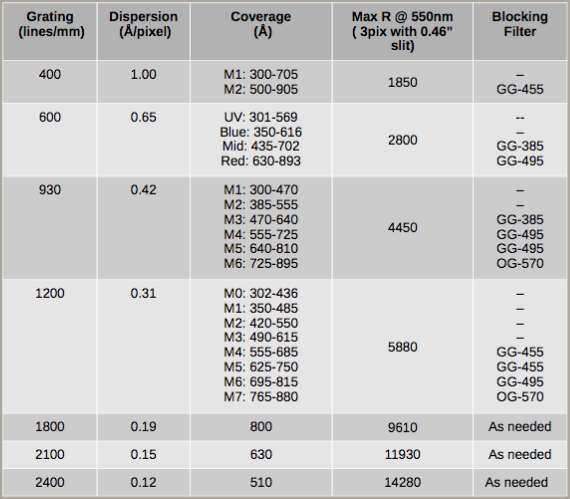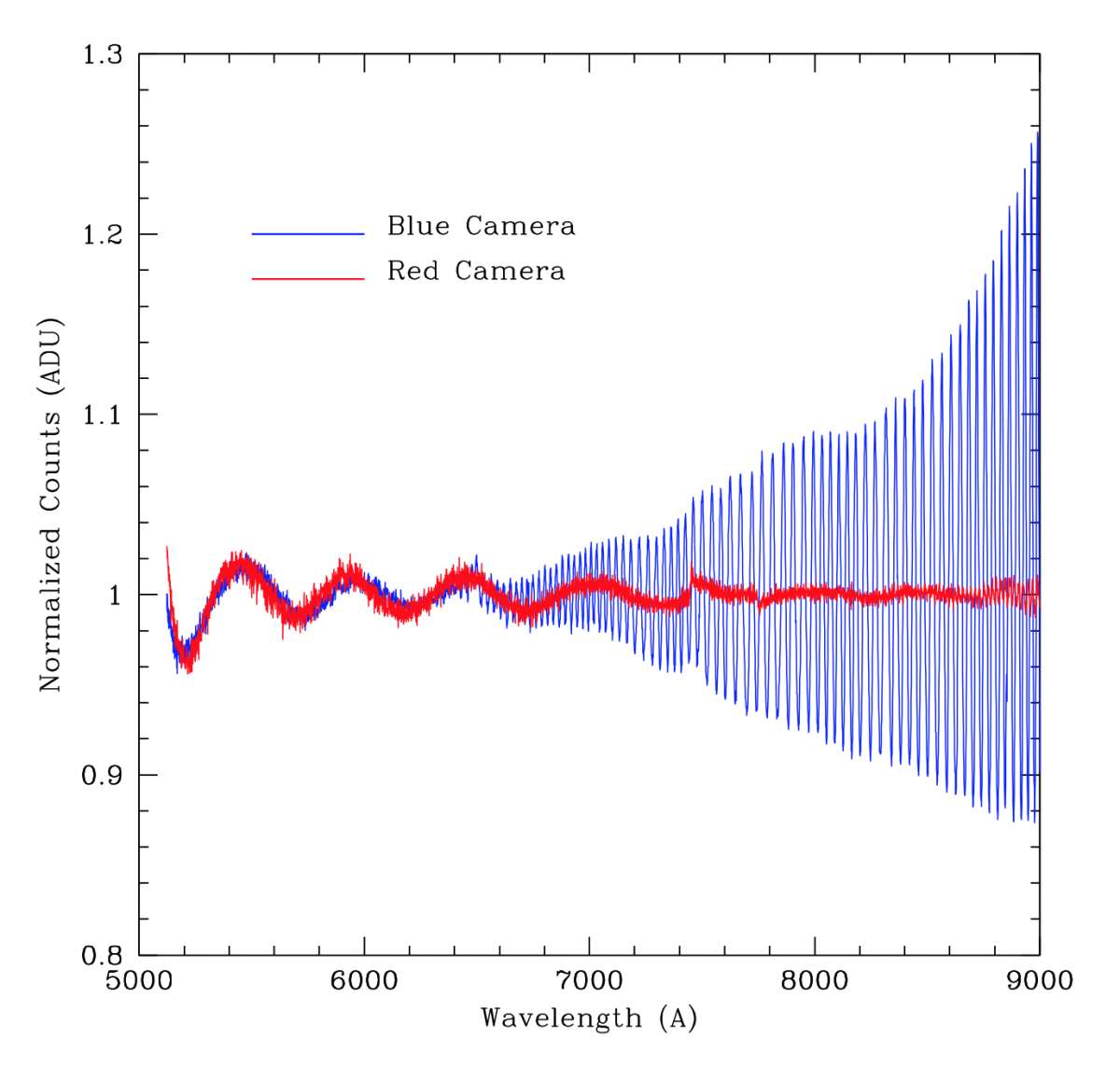Goodman Spectrograph Overview
Goodman Overview
Rev. Jun 2021
At least read this!
Optics:
The Goodman optics are designed to transmit down to the atmospheric cutoff at 320 nm, and include lenses made of CaF2 and of NaCl. The latter are the center elements of fluid-coupled triplets. None of the multiplets are over 4" in diameter which reduced the difficulty compared to spectrographs with larger pupil sizes. Each of the multiplets is sealed on one end with a face-mounted o-ring that imposes a known axial load, and on the other end with a rim-mounted o-ring that imposes a radial load, and finally held captive axially with a retaining ring that incorporates a third o-ring. This last o-ring does not participate in the sealing of fluid, but avoids a metal glass interface that would be undesirable for the CaF2 lenses. The salt lenses are held by the other optics and are never in contact with a seal.
Filters:
There are two independent filter wheels: One holds 4 x 4 inch square filters, and can be fit with 4 filters. The second wheel holds 4 inch diameter filters, and normally holds the 5 order-sorting filters.
- The imaging filters include SDSS u, g, r, i and z, and Bessell U, B, V, R I sets. Only 4 filters of the 4x4 inch imaging filters can be installed at a time.
- The spectroscopic order sorting filters includes GG-385, GG-455, GG-495, and OG-570 filters. These are always mounted (However, we expect observers to request them specifically in their Instrument Setup forms.)
The full list of available filters can be accessed in the SOAR filter list page.
The filters are in the collimated beam (tilted to avoid ghosts). Installing different filters is straight forward, but is a day-time operation. Special arrangements for fillter installations should be consulted with the Instrument Scientist well in advance of the observing run.
| Imaging Mode In imaging mode the plate scale is 0.15 arcsec/pixel and the field of view is 7.2 arcmin in diameter (3096 x 3096 unbinned pixels). Filters available include Bessell UBVRI, SDSS ugriz, and VR. See the SOAR filter list for other filters. |
 |
Spectroscopic Mode
In Spectroscopic mode the Goodman Spectrograph can obtain both single, longslit spectra and spectra of multiple objects simultaneously over a field of 3.0 x 5.0 arcminutes using multi-slit masks. A carousel style mask changer, holding up to 36 masks allows the slit plates to be interchanged and located at the instrument entrance aperture.
Single Slit masks:
The instrument is currently available with the following compliment of fixed long slits: 0.45, 0.60, 0.80, 0.95, 1.0, 1.2, 1.5, 1.9, 3.2, 4.0, and 10.2 arcsec wide. Each slit is 3.9 arcminutes long.
Note: the Goodman Acquisition Camera (GACAM) has a FOV=1.8 arcmin in its longest dimension, therefore, it does not span the full length of a Goodman long slit. If your science requires a full view of the long slit you will need to use the pre-imaging procedure for object acquisition (see the Step-by-step guide to Observing with Goodman).
Multi-Slit Object (MOS) masks:
Each Goodman MOS mask spans a field of view of 3x5 arcmin on the sky.
Within this field the user can arrange multiple slits of various width and lengths. The process of creating mask files for approved programs is the responsibility of each program PI. A Slit Designer software that runs on Windows 7 (a port for Mac OSX in in the works) has been developed by the Goodman Lab group at UNC. Masks are required to be sent to the following e-mail address: goodman-mos-ctio@noirlab.edu at least 1 month before the observations are scheduled. In your mask submission you need to attach the following files: FITS image of each field -with WCS-, and the .g, .msk, .txt files generated by the Slit Designer software. Currently, the PI also can access remotely a SOAR Windows 7 machine with a working Slit Designer software. For details, contact SOAR Goodman Support Scientists.
Gratings and Preset Observing Modes:
Up to three (3) gratings can be installed in the spectrograph at a time, in a linear stage which allows the rapid interchange of gratings. Installing different gratings is a day time operation. No grating changes are done during the night.
Goodman has now different Blue and Red-optimized options for the 1200 l/mm grating. Please check the updated list of currently available gratings in the Goodman Spectrograph Gratings page.
The table below shows the dispersion and the wavelength coverage for observations in our set spectroscopic modes. Please note that the 1800, 2100, and 2400 l/mm gratings are operated in Custom mode where the observer selects the central wavelength for their observations. Because of limits in the camera rotation stage, it is not possible to use the 2100 and 2400 l/mm gratings beyond certain wavelength limits.
The VPH gratings operate via Bragg scattering and their efficient operation requires Littrow or near-Littrow operation of the spectrograph. A grating rotation stage sets the incident angle to the desired value, which depends upon the line density of the grating and the central wavelength of interest. A concentric camera rotation stage must then be set to nearly twice this angle to intercept the diffracted beam. A set of fixed observing modes for each grating are given below, where applicable. All gratings can be used in the Custom mode.
Calibration Lamps:
We have a quartz lamp for spectral flats and HgAr, Ne, Ar, and CuHeAr lamps for wavelength calibration. Plots of these spectra with the lines identified in each of our standard spectroscopic modes can be found in the Goodman Comparison lamp web page.
With the 400, 600 and 930 line gratings we recommend also taking Dome Flats during your afternoon calibrations.
Choice of Detectors
If science program requires:
-
Best throughput down to UV atmospheric cutoff
-
It is an ongoing programs using Blue Camera
-
Maximum flexibility to create small ROIs on-chip, e.g., for fast time-series photometry
Most programs requiring wavelengths redward of ~4500 A will benefit from the enhanced red throughput and minimum fringing provided by the red camera.
Use of blocking filters:
Those taking spectra to the red of ~600nm should be aware that, depending on the spectrum of their target, there may be significant contamination from second order blue light superposed on the first order red spectrum (a blue leak). The blue leak will change the apparent shape of the red continuum, "fill in absorption features in the red, and may "imprint" emission or absorption features occurring in the blue spectrum at roughly twice their wavelength. This second order contamination can be eliminated by use of an appropriate blocking filter. However, this does entail a loss of efficiency in the red since the "in-band" transmission of the available blocking filters is not 100%.
Those needing spectrophotometric calibration should note that essentially all spectrophotometric standards are quite blue, so there will be a significant blue leak if they are measured without a blocking filter, which will invalidate the calibration of science target spectra, even if the targets themselves have no blue flux. A possible approach would be to measure the science targets without a blocking filter, the standards with one, and then correct the standards for the blocking filter transmission. However, we currently do not have measurements of the blocking filter transmission which we consider sufficiently reliable for these purposes. In the meantime observers who plan to do this should measure there own by observing a red star with and without blocking filter.
In principle contamination by the blue leak will also effect arc lamp calibrations (superposing blue lines on the red spectrum at roughly twice their wavelength) and flat fields. However, with the exception of the HgAr lamp the blue lines in all the calibration sources are very weak compared to the red lines, and similarly the flat field sources are much brighter in the red than the blue.
Scattered (and Stray) Light:
Measured to be small in imaging mode by comparing imaging FOV and surroundings with a bright star illuminating the pupil. Some scattered and stray light is seen in the Goodman spectroscopic mode. We currently see 0.06e/s of stray and/or scattered light in the spectroscopic mode with 1x1 pixel binning and the 100kHz ATTN2 readout. Efforts are underway to replace the tent that covers Goodman with a light-tight box. We are also looking for low-level emitting LEDs on all of the Goodman motors and covering them with metallic tape as we find them.
Calibration Issues:
Obtaining good quartz spectra over the entire wavelength range with the 400 l/mm grating is difficult because of the different spectral response at the red and blue ends. The most noticeable effect is that to obtain sufficient counts in the blue end, the red end becomes saturated. A blocking filter is on order so that composite quartz flats can be made. This effect is not as great with the other gratings because the wavelength range isn't as large.
There also exists contamination of the flats by scattering from the back of the second filter wheel. Use of the blocking filter mentioned above mitigates this contamination. Finally, with the BLUE CAMERA fringing appears in the spectra to the red of the Hα line. With the availability of the RED CAMERA, fringing at red wavelengths is greatly reduced, as can be seen in this plot below.
Flexure:
The instrument has active flexure compensation based on the Nasmyth rotator angle. The corrections are successful at the fraction of a pixel level for the full range of rotator angles.
Updated on July 26, 2024, 7:40 am




